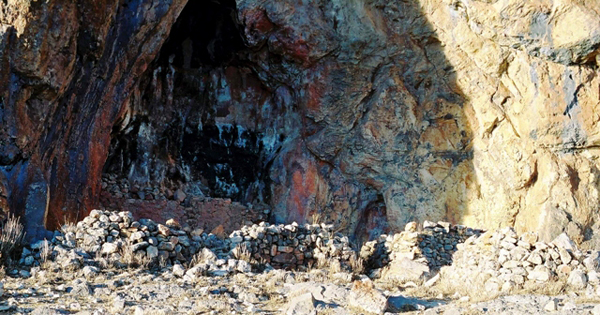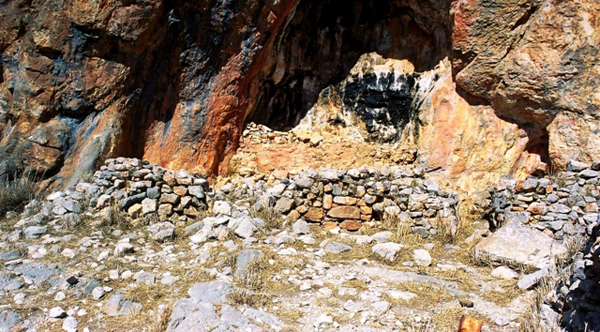
February 2014
John Vincent Bellezza
Welcome to another Flight of the Khyung! This voyage is to the haunts of a great but quirky ancient patriarch, Dragu Ngongen, of highest-most Tibet. We begin however by revisiting those intriguing individuals with drum-like and zoomorphic traits in the rock art of Upper Tibet. Originally, I planned to also present one of the oldest continually inhabited villages in Upper Tibet, but this will have to wait until the next Flight of the Khyung. Snowed over with other work, I am unable to write such a long newsletter this month. I think you will find, though, that this very special cultural site is worth waiting for.
To be or not to be a shaman: Extraordinary anthropomorphic figures in Upper Tibet and Siberia
As many readers will know, the December 2013 and January 2014 newsletters were devoted to Thakhampa Ri, one of Tibet’s most important rock art sites. I hope you liked the extraordinary figures holding what appear to be drums depicted at Thakhampa Ri.
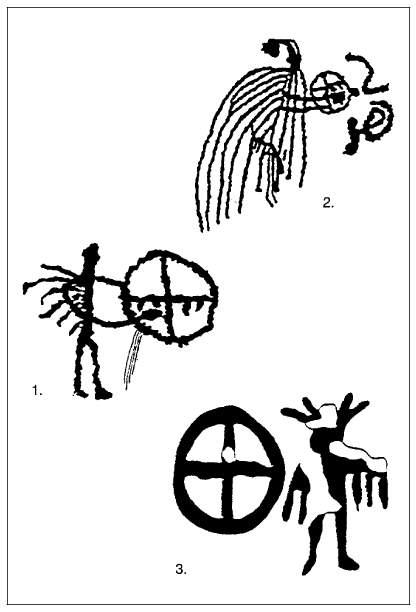
Fig. 1. Possible priestly or shamanic figures with drums in Siberian rock art. Image copyright E. Develet (see bibliographic information below). The caption reads: “Rock art images of shamans. 1. Oglakhty, Middle Yenisei River (after Miklashevich 1998); 2 Middle Yenisei River (after Kyzlasov and Leontiev 1980); 3. Mokhsogolokh- Khaja, Middle Lena River (after Okladnikov and Zaporozhskaja 1972)”

Fig. 2. Possible priestly or shamanic figure from Thakhampari. For analogous petroglyphs, including those with what appear to be avian features, see the December 2013 Flight of the Khyung.
Recently, I consulted diagrams of rock art from southern Siberia that are directly comparable to Thakhampa Ri.* In the Yenisei river valley there are two petroglyphs featuring individuals standing almost in profile. With the right hand they appear to beat a drum divided into four quarters. A series of lines resembling bird wings spread over the back of the two figures. While the overall depiction of these Siberian petroglyphs is somewhat different from those at Thakhampa Ri, the features specifically described characterize the art of both sites. A figure in a similar aspect was discovered along the Lena river as well (see fig. 1). According to Professor Ekaterina Devlet (whom I had the pleasure of meeting a few years back), this Yenisei and Lena river art portrays ancient shamans.
See E. Devlet’s “Rock art and the material culture of Siberian and Central Asian Shamanism”, in The Archaeology of Shamanism (editor: N.S. Price), pp. 43–55, Routledge: London, 2001.The book The Archaeology of Shamanism introduces the practices and paraphernalia of shamans from Inner Asia (and other regions of the world) in order to interpret material evidence from the archaeological record. The evidence presented by Devlet demonstrates that certain customs and traditions associated with Inner Asian shamanism of the 19th and 20th centuries have long antecedents in the cultures of this diverse region. Yet, these correlations, however extensive and strong, do not positively establish that the shamanism of recent times existed in the ancient period. Similarities in material form do not necessarily equate with similarities in function and belief. Time is witness to many modifications in human expression and adaptation, and why should it be otherwise for the folk-religious practitioners of Inner Asia?
Although we can surely posit a degree of historical continuity, to place 3000 or 4000 years of religious and ritual practice into a single conceptual framework called ‘shamanism’ may impede the ability of archaeologists and historians to appreciate the dazzling richness of human culture. To refer to the ritualists, diviners, and ecstatics of a great many peoples under the category ‘shaman’ is tantamount to lumping together all of today’s major world religions under the banner ‘messianic’, because they believe in a divine figure who will return one day to save their followers from perdition. Such a system of classification is useful in understanding religious phenomena but only in the broadest sense.
As the two figures from Yenisei are shamans or shaman-like in appearance, should we apply the same label to the Thakhampa Ri drummers? I think only as a general designation, otherwise it might confound the ancient religious record. In anthropological literature, the term shaman is often associated with the simplest forms of social organization and technological development worldwide, those peoples who live in bands and tribes. By the protohistoric period (100 BCE–600 CE: the time in which most of the Thakhampa Ri art was presumably made), Upper Tibet possessed a civilization as technologically advanced, at least in some respects, as that of her neighbors in India, Central Asia, and further afield in China. In these other regions, religious practitioners are often described as priests, adepts, sages, oracles, sorcerers, hierophants, or mystics, as well as shamans. This variable terminology is to some degree a matter of semantics, but it also reflects the more complex social organization of peoples with large permanent settlements and a significant degree of occupational specialization.
Moreover, Tibetan literature portrays pre-Buddhist personalities as closely allied to the royalty and availing themselves of every technological, economic, and social facility available. To call such religionists ‘shamans’ does not adequately convey their sophisticated Iron Age way of life. A complementary argument was made by the well-known Bon religious specialist Professor Per Kværne, who 40 years ago argued against the class of ancient Tibetan ritualists known as shen (gshen) being termed shamans, as their origins and practices were simply too wide to be subsumed under that term.*
See Per Kværne: “Aspects of the Origin of the Buddhist Tradition in Tibet”, in Numen, vol. 19, no. 1 (April), pp. 22–40. Brill: Leiden, 1972.While it is conceivable that the rock-art-making hunters and pastoralists of Thakhampa Ri belonged to more primitive social groups than the holders of the great castles and temples, there can be little doubt that they were woven into the same cultural fabric, for protohistoric rock art in close proximity to these kinds of installations is of the same kind as Thakhampa Ri.
It is important to recognize that any occupational label applied to extraordinary anthropomorphs (actual or supernatural figures in human form) in Tibetan rock art is nominal, a means of provisionally identifying their purpose and function. Furthermore, it must be considered that the Thakhampa Ri drum-wielding figures may possibly have a mythic or divine nature, not a human one. We are unable to make a binding determination either way.
Call them what you will, the remarkable stylistic parallels between the Siberian and Thakhampa Ri figures stand. Provided this rock art belongs to, or can be related to, cultural phenomena of the same time-frame (the age of the Siberian art is unclear to me), linkages between Upper Tibet and north Inner Asia may well be indicated. In any case, there is a growing body of archaeological and textual evidence available to postulate cultural interconnections between these far-flung regions (a major focus of my research, as many of you know). If the drum-beaters of Siberian and Upper Tibetan rock art do indeed represent analogous religious functionaries, this interrelationship is likely to have been underpinned by antecedent customs and traditions, as encapsulated in the widespread distribution of rock-art chariots, emblematic human visages, and Eurasian ‘animal art’ of the Bronze Age and Iron Age.* These transcultural art forms owe their existence to powerful and pervasive aspects of psychosocial experience that transcended the bounds of discrete human groups.** The precise mix of ideological, economic, political, and environmental factors involved in accounting for the transcultural phenomenon of Inner Asian ‘shamans’, however, remains beyond our grasp.
For more information about these types of rock art, see L. Bruneau and J. V. Bellezza: 2013. “The Rock Art of Upper Tibet and Ladakh: Inner Asian cultural adaptation, regional differentiation and the ‘Western Tibetan Plateau Style’ in Revue d’Etudes Tibétaines vol. 28, pp. 5–162. A nonspecific connection between the ancient religious traditions of Upper Tibet and north Inner Asia was propounded by Professor Helmut Hoffmann more than a half century ago. He held that the ‘Bon’ religion originated in western Tibet and was the ‘national’ counterpart of central and north Asian shamanism. See H. Hoffmann: 1961. The Religions of Tibet (trans. E. Fitzgerald). London: George Allen & Unwin, 1961.Although transcultural phenomena contributed to the unfolding of artistic processes, as seen in the rock art record of ancient Siberia and Upper Tibet, these regions have long since separated culturally (save for the spread of Tibetan Buddhism in southern Siberia, beginning in the 13th to 17th centuries CE). Whatever their origins and early cross-fertilization, in recent centuries Siberian shamanism and Upper Tibetan spirit-mediumship operated as parallel phenomena. The ostensible continuities in the archaeological and historical records of each region warrant further use of ethnoarchaeological approaches for elucidating the significance of the extraordinary anthropomorphs under consideration and other ‘shamanistic’ phenomena . This type of research and analysis may shed more light on the relationship between the past and present in Siberia and Upper Tibet and on how these regions may have influenced one another in antiquity. There is surely lots of fertile ground here for more research and analyses.
The haunts of Dragu Ngongen: Yesterday’s venerable cultural hero, today’s wily ancestor
The archaeological site on the hill
In my first book, Divine Dyads: Ancient Civilization in Tibet (for bibliographic information, see http://www.tibetarchaeology.com/books/), I describe an archaeological site known as Dragu Tara (Bra-gu rta-ra: Horse Corral of Dragu [Ngongen]). This site is connected to a warrior and ancestral figure of the local herders named Dragu Ngongen (Bra-gu ngom-ngan). It boasts what appears to be the single largest archaic era monument in the southeastern Changthang (Byang-thang). The massively built walls of Dragu Tara represent the possible vestiges of a hilltop stronghold and/or elite residence. However, as so little remains of various ancillary structures at the site, a prime ceremonial or ritual function for Dragu Tara, rather than a residential function, cannot be precluded.

Fig. 4. The crumbling walls of Dragu Tara from the west, with the sparkling blue waters of a sacred lake in the background. The site overlooks an inlet, one of many on this lake. Note the cairn with prayer flags on the right (south) wall.

Fig. 5. The now discontinuous east wall of the main structure of Dragu Tara. Orange climax lichen is just visible on some of the eroded stones of this wall.
The formidable complex of Dragu Tara was planted on top of a hill that splits a side valley of the lake into two halves. The site has an optimal location in that it overlooks a large watery expanse to the east, a preferred location for archaic residential sites in Upper Tibet. Its central feature is an open, walled rectangular structure suspended approximately 25 m above the valley floor. The perimeter walls of this structure are quite closely aligned in the cardinal directions. The up to 2 m tall walls form a large enclosure, measuring 57 m (east-west) by 28 m (north-south). These dry-mortar random-rubble walls are around 80 cm in thickness, and were constructed with granite blocks 30 cm to 80 cm in length. Orange climax lichen clings to some of the highly worn stones of the walls.

Fig. 7. In the foreground is the wall that bisects the main structure into two equal parts. On the south (right) wall there is a shrine with prayer flags. On the extreme right side of the image, a promontory terminating in a conical formation is visible. This is Nying Do (sNying-do: Heart Headland), a landform thought to have been instrumental in Guru Rinpoche’s subjugation of the sacred lake and her mountain mate in the 8th century CE. At Nying Do there is a large cairn, as well as traces of around ten groups of structures, once an extensive residential site. According to local lore, these are the remains of an ancient Bon ‘monastery’.
There are the remains of a wall dividing the main structure of Dragu Tara into two equal halves, east and west. There are also the footings of a number of walls further subdividing the enclosure into various parts. These obscured remains may have possibly once supported buildings. On the northeast corner of the main structure are wall footings (13 m x 5.8 m), which appear to have given rise to two buildings. On the southwest corner of the east half of the enclosure there is another foundation (12 m x 13.5 m). On the northwest corner of the structure there appears to have been another such foundation. Just outside the west wall of the main structure are the footings of two collateral structures, measuring 11.8 m (north-south) by 7 m (east-west).

Fig. 10. The east wall (left side of photo) and the eastern half of the south wall of the main structure at Dragu Tara. A shrine with prayer flags is plainly visible.

Fig. 11. A close-up of the shrine known as a lhatho in Tibetan. Note the cords of braided white sheep wool. The tufts and knots in each cord are equivalent in number to the age in years of the individual who erected the prayer flags. This old custom of tying knots is a way of propitiating elemental deities and deified ancestors in Upper Tibet. It is believed to help bring votaries into intimate contact with the object of their prayers and aspirations.
As part of the south wall of the main structure there is a shrine consisting of a prayer flag draped cairn built with large boulders. This shrine, called a lhatho (lha-tho: ‘registry of the gods’ ), comprises the ritual heart of the site. Native shepherds come here to pray and offer incense to their most famous patriarch, Dragu Ngongen.
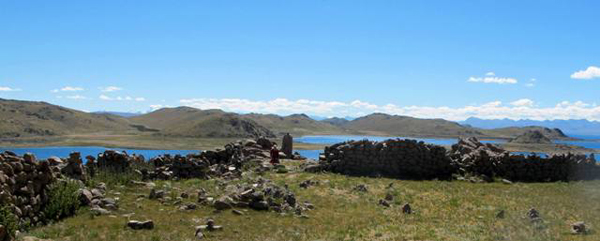
Fig. 12. Visible beyond the walls of Dragu Tara and the individual sitting in the photograph is a large natural pillar of rock called Thanglhai Taphur.
Just east of Dragu Tara is a 2 m tall natural pillar of rock known as Thanglhai Taphur (Thang-lha’i rta-phur: Horse Stake of [gNyan-chen] thang-lha), where prayers and offerings are made to this great territorial god (yul-lha) and to the horse gods (rta-lha) in his retinue. This worship is purported to insure the health and fecundity of the herders’ horses. Offerings left at Thanglhai Taphur are all related to horses and include old bits and braided reins and halters. It is reported that in the Chinese Cultural Revolution, Dragu Tara was damaged and its shrines desecrated. During the period of livestock collectivization, the main structure was rehabilitated for use as a pen. Since the 1980s, the site has reverted back to a religious function.
Another archaeological site in the region associated with Dragu Ngongen is Dzongmar (rDzong-dmar: Red Fortress).* Located on an island, it is said to have been a three-storied stone building. Unfortunately, this structure was heavily damaged in the Chinese Cultural Revolution. My explorations reveal that the host island was probably the headquarters or a major place of refuge for archaic religious practitioners in southeastern Tibet. After the subjugation of the last archaic religious cults, Dzongmar devolved to the Buddhist lama Dopa Darshe (Do-pa dar-shes: born 1228 CE).
This site is described in Antiquities of Zhang Zhung (site B-127); see www.thlib.org/bellezza.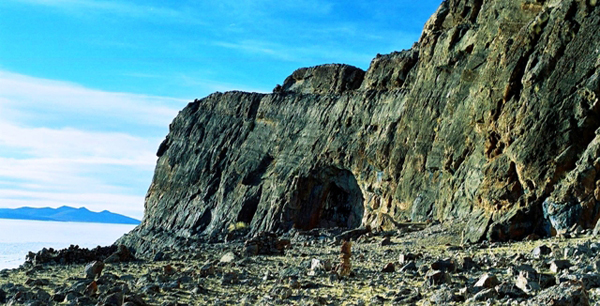
Fig. 13. Dzongmar is situated in the large round overhang of the formation. This formation is said to have the shape of an elephant.
The oral tradition
Local legend holds that Dragu Tara was built by Dragu Ngongen to hold his 100 horses, underlining the wealth and prominent position of this ancient luminary. Dragu Ngongen shared the gigantic corral with his younger brother, Ajo Pöndrak (A-jo [d]pon-brag), who owned only one horse. The extreme differences in their wealth led to certain problems. The shepherds humorously relate how Dragu Ngongen thought that since Ajo Pöndrak had only one horse he should give it to him to be rid of the trouble of having to care for it. On the other hand, Ajo Pöndrak believed that because he had only one horse and his brother 100 horses, Dragu Ngongen should give him a few of them. This tale mirrors an economic reality on the Changthang: that of great disparities in wealth which can arise when a younger brother strikes out on his own with the family’s herds, who are left without recourse.*
For more on the oral tradition of Dragu Tara and Dragu Ngongen, see the book Divine Dyads (bibliographic information at http://www.tibetarchaeology.com/books/).Dragu Ngongen is the deified ancestor of the pastoralists of southeastern Tibet, the Apahor. This is exemplified in his classification as a melha (mes-lha: ancestral spirit of the patriline) and masang (ma-sangs: a well-known group of nine Tibetan progenitors). Dragu Ngongen belonged to the Dra (dBra / sBra) proto-clan or proto-lineage. This is confirmed in an oral tradition that was preserved by senior monks at Phurbu (Phur-bu) monastery in Zhungru (gZhung-ru), Saga (Sa-dga’) county. In this tradition, he is called Dragu Ngonön (dGra-dgu ngo-gnon: Face Pressed Downwards) and lived in the Targo (rTa-sgo) region of the central Changthang. Many generations ago, emigrants from Targo brought this folklore with them to Zhungru. The Dragu Ngongen of the Apahor tribe is also aligned with the Targo region.
The dBra are considered one of the six major genealogical groupings of Tibet, the ‘Six Clans of Tibetan Little Men’ (Bod-mi’u gdung-drug). The dBra proto-clan seems to have had two main branches, the Se (bSe) and Khyung, both of which have lent their names to regions in western Tibet (bSe-’khor, Khyung-byang, Khyung-lho, etc.). However the dBra was composed, a cosmogonic and genealogical text preserving lore from Tibet’s imperial period (circa 650–850 CE), dBu nag mi’u ’dra chags, places this proto-clan in western Tibet and Ladakh, as well as in other regions of the Plateau. This text provides the names of several clans in western Tibet said to have sprung from the dBra. Interestingly, indigenous regions and gods share the same names as these western Tibet offshoot clans. That clans, divinities, and regions possess identical appellations, as well as these places and personalities being identified with Zhang Zhung in dBu nag mi’u ’dra chags, alludes to their deeply ingrained historical status in Upper Tibet. It seems likely that Dragu Ngongen belonged to the branch of the dBra known as Drawo (Bra-bo) in the dBu nag mi’u ’dra chags. This derivative clan is associated with the ‘middle’ (bar) zone of Tibet.* Another subsidiary clan of the middle zone is Gazi (Ga-zi), which gave rise to the main protector gods of the Taklung Kagyü (sTag-lung bka’-brgyud). These gods were ‘born’ at the main monastery of this Buddhist subsect, which is situated only 100 km from the heartland of Dragu Ngongen.**
For more information about most matters touched upon in the above two paragraphs, consult the book Zhang Zhung (bibliographic information at http://www.tibetarchaeology.com/books/). On the theogony of these Taklung Kagyü protectors, see the book Calling Down the Gods (bibliographic information at http://www.tibetarchaeology.com/books/).According to legends circulating in the southeastern Changthang, the father of Dragu Ngongen was a sky god (lha) and his mother a human being. Those personalities with sky gods as fathers are called lhabu (lha-bu) or lhasin (lha-sras), meaning ‘son of the sky god’. These epithets can be traced back to the Dunhuang manuscripts and other Old Tibetan literature. It is said that the consort of Dragu Ngongen, was a terrestrial spirit (srin-mo), fierce entities acting as the wellspring of female lineages in Tibet’s oldest ritual literature. With the almost complete conversion of southeastern Changthang to Buddhism in the early 13th century CE, Dragu Ngongen was transformed into a generalized ancestral figure. I have not found even a single Apahor family that claims direct descent from him.
In one folktale, Dragu Ngongen camps out with his herd of yaks. That evening, after making offerings of sausages to the assemblies of white sky deities (lha) and blue underworld deities (klu), they gifted him a beautiful white female yak. In his dreams, these classes of binary spirits referred to Dragu Ngongen as ‘sinpo (srin-po)’, an ancient epithet for the Tibetan people. This title bespoke the savage character of Tibetans as well as their telluric maternal lineage (part of the prevalent mythic theme of fundamental dyadic arrangements in Tibetan culture). Ajo Pöndrak, the proud and acquisitive brother of Dragu Ngongen, demanded to know how his brother had obtained the lovely white female yak. Dragu Ngongen related his story, prompting Ajo Pöndrak to think that he could obtain wealth in the same manner. Ajo Pöndrak camped in the same location with his herd, but he did not make the stipulated offerings of sausages to the dichotomous spirits. In retaliation, these spirits caused him to become very cold, injured his face, dispersed his herd, and had a wolf eat his horse.*
For the complete folktale, see the book Antiquities of Northern Tibet (bibliographic information at http://www.tibetarchaeology.com/books/).In another legend of the southeastern Changthang documented in Divine Dyads, the mountain god Targo had an affair with Lake Nam Tsho. Mount Nyenchen Thanglha, the husband of Nam Tsho, enlisted the support of Dragu Ngongen to help defeat Targo. Dragu Ngongen stole the horses of this mountain spirit, serving as a diversion, while Thanglha reclaimed Nam Tsho. Targo pursued both Nam Tsho and his horses, but Dragu Ngongen attacked him with a shower of arrows shot from his bow. Targo eventually tired of the chase and returned home without his horses or the goddess. As a reward for his assistance, Thanglha said he would give Dragu Ngongen anything he requested. Dragu Ngongen had the audacity to ask for the gorgeous goddess Nam Tsho. As he had given his word, Thanglha had no choice but to grant Dragu Ngongen his wish.
Subsequently, in the guise of a shepherdess, Nam Tsho announced to Dragu Ngongen that in ten months time, on the full moon, she would present him with a child. As a result, he was full of pride and had over-inflated ideas about himself. When the appointed day arrived, Dragu Ngongen dressed up in full military regalia and went to the lake to receive his child. As he waited, Dragu Ngongen spied a female wild yak licking its baby clean. Thinking it was game, he killed the calf with an arrow. Instantaneously, the wild yak turned into the goddess Nam Tsho. She furiously denounced Dragu Ngongen for killing his own child. Overcome with grief, Dragu Ngongen resolved to commit suicide, but after a couple half-hearted attempts he gave up trying to take his own life. Dragu Ngongen then started to think that he had bested both Thanglha and Nam Tsho. He returned home feeling triumphant.
As one can see in these folktales, Dragu Ngongen and his younger brother are portrayed as self-serving and rather silly fellows. Amusing at best, these are not the kind of figures from which anyone would want to claim decent. This disparagement of ancestral personalities represents a historical distortion, one largely attributable to a reengineering of the cultural record under Buddhist influence. It appears that Buddhist Tibetans felt compelled to distance themselves from people and traditions belonging to the pre-Buddhist archaic past. For example, the tale of Dragu Ngongen triumphing over Thanglha and Nam Tsho subtly shows that humans are more precious than the ‘worldly’ deities. In Buddhist terms, this is so because they alone can achieve enlightenment through the practice of Dharma.
The historical tradition
Like many oral traditions, the one concerning Dragu Ngongen is not very well historicized. The Apahor sometimes hold that he lived before the time of Guru Rinpoche in the 8th century CE, clear acknowledgment of his pre-Buddhist historical and cultural environment. Nevertheless, his lineage and religious affiliations appear to have persisted until the early 13th century CE and the conversion of nearly all of the southeastern Changthang to Buddhism. To this day, one Bon enclave survives a little northwest of Lake Nam Tsho, in Poche (sPo-che). These Bonpo are, of course, Lamaist practitioners.
The cultural and political events that led up to Lamaist Bon replacing the archaic cults of the region have not endured in any detail, and there is little reason why they should have. By 1000 CE, Tibetan religious history was being rewritten wholesale by the Bonpo and Buddhists, bringing them in conformity to Buddhist ethics, teachings, and sensibilities.*
For a fascinating example of this process, specifically as relates to destructive rituals, see Bellezza, in press: “Straddling the Millennial Divide: A case study of persistence and change in the Tibetan ritual tradition based on the Gnag rabs of Gathang Bumpa and Eternal Bon documents, circa 900–1100 CE” in Revue d’Etudes Tibétaines vol. 29, 88 pp. Paris: CNRS, 2014. http://himalaya.socanth.cam.ac.uk/collections/journals/ret/One of the most valuable sources describing the final chapter in the conversion of the southeastern Changthang to Buddhism is the Taklung Kagyü religious history sTag lung chos ’byung, written by Ngawang Namgyal (Ngag-dbang rnam-rgyal: 1574–1621 CE). The relevant section consists of the biographies of Sangye Yarchon (Sangs-rgyas yar-byon: 1203–1272 CE) and two of his disciples, Kongpo Darshe (Kong-po dar-shes: 1228–1310 CE) and Dringtön Shakya (’Bring-ston shākya: 1225/1237–1312/1324 CE). This textual source is studied in the book Divine Dyads.
sTag lung chos ’byung associates the southeastern Changthang with the personality Masang Dau Ngongen (Ma-sangs dwa’u ngo-ngan), an individual closely related (but probably not identical) to Dragu Ngongen, as his name and attribution to the masang progenitors indicates. This is confirmed in a pilgrimage guide (gnas-bshad) by the late Taklung Tsetrul Rinpoche, one of the greatest Taklungpa lamas of the last century. It seems likely that Masang Dau Ngongen was a descendant of Dragu Ngongen, but how many years there were between these two figures is unclear. According to Taklung Tsetrul’s guide, Masang Dau Ngongen was initiated as a young and powerful man by the 13th century CE lama, Sangye Yarchon. The complete religious conversion of Masang Dau Ngongen was accomplished by the Taklung lama Dringtön Shakya and by the Drigung Kagyü (’Bri-gung bka’-brgyud) lama Shakya Rinchen (Shākya rin-chen: 13th century CE). This led to the death of Masang Dau Ngongen, apparently through destructive tantric ritual practices unleashed to bring about his subjugation.
The destruction of the religious and political apparatus associated with the last of the non-Buddhist leaders, Masang Dau Ngongen, coincided with the defeat of a group called the Bonpo by the Taklung lama Kongpo Darshes. This story is also related in the sTag lung chos ’byung. Kongpo Darshes and the Bonpo held a heated debate overseen by the Bon headman Sengge Pal (Sengge dpal). According to the biography, Sengge Pal favored the Bonpo because he was a corrupt individual. Evidently, this debate was intended to make the Bonpo abandon their religion and come under the authority of the Taklungpa. The ploy, however, was unsuccessful. Loosing the debate deeply angered Kongpo Darshe, so he practiced destructive magic against the Bonpo, causing them to become afflicted with a lethal condition called the ‘red disease’ (dmar-nad). It is written that the Bonpo, too, deployed wrathful magic (mthu) against Kongpo Darshe. In this war of ritual magic, the Buddhists emerged victorious and Sengge Pal and other Bonpo lay dead.
According to the sTag lung chos ‘byung, the Taklungpa and other Kagyü sects were up against two non-Buddhist adversaries. Reading between the lines, the defeat of both of these enemies was necessary if the Buddhists were to emerge as the paramount political and religious force in the southeastern Changthang. One of their rivals was of course Masang Dau Ngongen, who we can probably take as the leader of a vestigial archaic cult that appears to have been an important faction in the region. The other enemy were the Bonpo, the Lamaist counterpart presumably of the Kagyü sects. These Bonpo also had to be vanquished in order to establish Buddhist ecclesiastic hegemony over the southeastern Changthang.
The history outlined above is needless to say sketchy, but the outcome is clear to see in the archaeological record of the southeastern Changthang. The ancient monumental sites associated with the archaic cults and the Bonpo fell into ruin, and much of their history was lost. The noble Buddhist Dharma would remain the prime spiritual and cultural force in the southeastern Changthang for the next 700 years. Yet, it was prior to the Buddhist era that civilization, as measured by its monumental remains (and possibly population), reached its greatest extent in the region. Reclaiming this ancient heritage, both pre-Buddhist and Buddhist, could act as a cultural anchor for Tibetans in the 21st century, a century already proving to be a time of tumultuous change worldwide.
Next month: The thousand year-old village and the start of other interesting features too!




